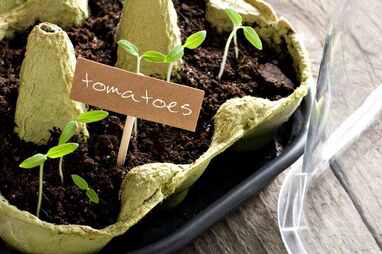 It’s that time of year to start plants like tomatoes and peppers indoors. Here’s a few tips on starting them on a budget using items you can recycle around the house. MATERIALS NEEDED ✓ Egg cartons ✓ Tomato & Pepper Seeds ✓ Scissors or sharp knife ✓ Pencil ✓ Organic Potting Soil ✓ Spray bottle ✓ Full spectrum LED or fluorescent bulb ✓ Balanced, general-purpose organic liquid fertilizer STEPS 1. Cut the lid from an egg carton with scissors or a sharp knife. 2. Poke a small drain hole in the bottom using the tip of a pencil or sharp object. 3. Place the egg carton lid under the bottom to create a drainage tray. 4. Fill the egg cells 3/4 full with organic potting soil. 5. Plant two or three seeds on top of the potting mixture in each cell. Cover the seeds with a thin layer of potting mixture. Refer to the seed packet for specific depth requirements. 6. Water with a spray bottle or turkey baster. Mist as needed to keep the potting mixture lightly moist. Don't over-water, it will become anaerobic and encourage bacteria to grow. 7. Place the egg cartons in a warm area to encourage germination. Sunlight isn’t required during this stage. Most seeds germinate in temperatures between 60 and 80 degrees Fahrenheit. 8. After seedlings sprout, thin to one seedling per cell. 9. Place the seedlings under a full spectrum Fluorescent or LED bulb, with 6 inches between the bulb and the top of the seedlings. You can use a clamp lamp or if you are growing a lot, use a shop light. 10. Fertilize the plants once a week if the seedlings are pale green or yellowish green. Use a weak solution of a balanced, general-purpose liquid fertilizer with a ratio such as 14-14-14 or 20-20-20. Mix the solution at 1 tablespoon of fertilizer in 1 gallon of water. 11. In 10-12 weeks seedlings will be ready to be transplanted outdoors. #seedstarting #organicgardening #zone8b #austin organicgardeners #growtomatoesindoors #startseedsineggcartons #recyclinginthegarden #thegrowthcycle |
AuthorWrite something about yourself. No need to be fancy, just an overview. Archives
May 2024
Categories |
 RSS Feed
RSS Feed